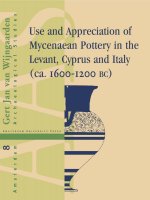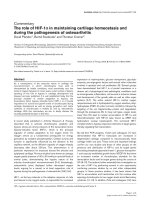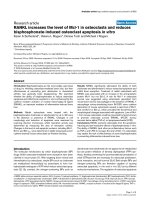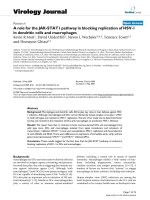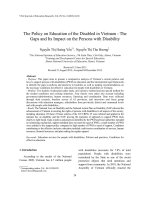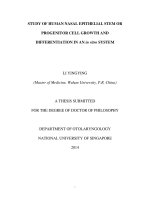Dual functions of AP 1 in neuronal cell death and differentiation
Bạn đang xem bản rút gọn của tài liệu. Xem và tải ngay bản đầy đủ của tài liệu tại đây (2.04 MB, 152 trang )
DUAL FUNCTIONS OF AP-1 IN NEURONAL CELL
DEATH AND DIFFERENTIATION
LI LEI
M. Sc. (PUMC&CAMS)
A THESIS SUBMITTED FOR THE DEGREE OF
DOCTOR OF PHILOSOPHY
INSTITUTE OF MOLECULAR AND CELL BIOLOGY
NATIONAL UNIVERSITY OF SINGAPORE
2005
ACKNOWLEDGEMENTS
I would like to express my sincere gratitude to my supervisor, Professor Alan
Porter, for providing me the wonderful opportunity to pursue my PhD degree in his
laboratory. I am grateful to Alan for his continuous encouragement, support as well as
guidance throughout these years.
I am thankful to my graduate supervisory committee, Drs. Victor Yu and Edward
Manser for their constructive suggestions and critical comments.
I would also like to thank past and present members of the AGP laboratory for
their helpful discussion, technique assistance, cooperation and friendship. Especially
thanks go to Dr. Zhiwei Feng for his patience, guidance as well as helpful suggestions.
I thank all members in VY lab for idea sharing at our Apoptosis Club.
I appreciate very much the friendship with Dr. Tong Zhang, Dr. Jormay Lim and
Dr. Zhihong Zhou. The wonderful time we spend together in IMCB will be in my mind
forever.
My heartful appreciation goes to my beloved parents for their constant support
and encouragement, without whom this would have remained but a dream. Finally, my
deepest gratitude goes to my husband for his unconditional love, understanding and
warm support through the years.
i
TABLE OF CONTENTS
ACKNOWLEDGEMENTS............................................................................................. i
TABLE OF CONTENTS................................................................................................ ii
LIST OF FIGURES…………………………………………………………………….v
LIST OF TABLES........................................................................................................ vii
ABBREVIATIONS ..................................................................................................... viii
LIST OF PUBLICATIONS ............................................................................................ x
SUMMARY................................................................................................................... xi
CHAPTER 1
INTRODUCTION ............................................................................... 1
1.1 Programmed cell death ......................................................................................... 1
1.2 Nitric oxide in health and disease ......................................................................... 7
1.2.1 Formation and chemistry of nitric oxide........................................................ 7
1.2.2 Influence of nitric oxide on important cellular organelles........................... 13
1.2.3Effects of nitric oxide on some important cellular proteins.......................... 19
1.2.4 Understanding the paradoxical effects of nitric oxide on cell viability ....... 23
1.3 AP-1 and programmed cell death ....................................................................... 26
1.3.1 Regulation of AP-1 activity as a transcription factor................................... 26
1.3.1.1Transcriptional regulation of c-jun and c-fos expression....................... 27
1.3.1.2 Posttranslational regulation of c-Jun, c-Fos and ATF2 ........................ 29
1.3.1.3 Regulation of AP-1 activity by its interacting proteins ........................ 30
1.3.2 Role of AP-1 in cell proliferation and differentiation.................................. 31
1.3.2.1 Role of AP-1 in cell proliferation ......................................................... 31
1.3.2.1.1 AP-1 is an important regulator in cell proliferation....................... 31
1.3.2.1.2 Mechanisms of AP-1 modulation of cell proliferation .................. 33
1.3.2.1.3 AP-1 is a mediator of oncogenic transformation: the mechasnisms
...................................................................................................................... 34
1.3.2.2 Role of AP-1 in cell differentiation ...................................................... 36
1.3.3 Role of AP-1 in cell death............................................................................ 39
1.4 Thesis Rationale……………………………………………………………….44
CHAPTER 2
MATERIALS AND METHODS ..................................................... 45
2.1 Chemicals and reagents ...................................................................................... 45
ii
2.2 Cell culture.......................................................................................................... 46
2.3 Transfection of mammalian cells........................................................................ 46
2.3.1 Transcient transfection using LIPOFECTIN ............................................... 46
2.3.2 Stable transfection using LIPOFECTIN ...................................................... 47
2.4 Molecular cloning ............................................................................................... 48
2.4.1 Construction of expression plasmids ........................................................... 48
2.4.2 Preparation of Escherichia. coli competent cells......................................... 49
2.4.3 DNA transformation .................................................................................... 50
2.4.4 DNA preparation.......................................................................................... 50
2.5 Polymerase chain reaction (PCR) ....................................................................... 52
2.6 Site-directed mutagenesis ................................................................................... 53
2.7 Sytox/Hoechst DNA staining.............................................................................. 53
2.8 Cell death assay .................................................................................................. 54
2.9 Reporter assay..................................................................................................... 55
2.10 Caspase-3 activity assay ................................................................................... 56
2.11 SDS-polyacrylamide gel electrophoresis (SDS-PAGE) ................................... 56
2.12 Western blot analysis ........................................................................................ 57
2.13 Phospho-Jun and -JNK assay............................................................................ 58
2.14 Peptide inhibition assay .................................................................................... 58
2.15 RNA preparation............................................................................................... 58
2.16 Microarray analysis........................................................................................... 60
2.17 Induction of neuronal differentiation ................................................................ 60
2.18 Preparation of whole cell lysates ...................................................................... 60
2.19 Preparation of nuclear extracts ......................................................................... 61
2.20 Detection of proteins released into the cell culture medium............................. 61
2.21 Eletrophoretic Mobility Shift Assay (EMSA) .................................................. 62
2.22 Annexin V staining ........................................................................................... 62
2.23 Semi-quantitative RT-PCR analysis ................................................................. 63
2.24 RNA interference .............................................................................................. 64
CHAPTER 3
JNK-dependent phosphorylation of c-Jun on Ser-63 mediates NO-
inducible apoptosis in human SH-Sy5y neuroblastoma cells ....................................... 65
3.1 NO induces concentration-dependent apoptosis in SH-Sy5y cells..................... 65
3.2 JNK activation correlates with c-Jun phosphorylation of Ser-63 in response to
NO during apoptosis in SH-Sy5y cells ..................................................................... 66
iii
3.3 c-Jun phosphorylation is not dependent on p38 kinase ...................................... 68
3.4 Ser-63 phosphorylation alone mediates NO-induced apoptosis as well as c-Jun
and AP-1 transactivation in response to NO in SH-Sy5y cells................................. 69
3.5 Caspase-3 contributes to NO-induced cell death downstream of c-Jun
phosphorylation in SH-Sy5y cells ............................................................................ 74
3.6 Evidence that c-Jun phosphorylation in response to NO is directly dependent on
JNK in SH-Sy5y cells ............................................................................................... 76
3.7 Evidence that JNK-mediated c-Jun phosphorylation on Ser-63 is a general
phenomenon in NO-induced apoptosis of neuroblastoma cells................................ 79
3.8 Discussion........................................................................................................... 81
CHAPTER 4 sgII, an AP-1 target gene, is a new class of proteins that mediate
neuroprotection from NO-induced apoptosis and NGF-induced neuronal differentiation
in SH-Sy5y cells ........................................................................................................... 85
4.1 Dominant-negative c-Jun (TAM-67) sensitizes SH-Sy5y cells to NO-induced
apoptosis ................................................................................................................... 86
4.2 Protective gene expression is partially responsible for counteracting NO-toxicity
.................................................................................................................................. 90
4.3 sgII, a potential AP-1 target gene, shows an NO-inducible and AP-1- dependent
expression pattern in SH-Sy5y cells ......................................................................... 93
4.4 SgII plays important roles in neuroprotection in NO-induced apoptosis as well as
in NGF-induced neuronal differentiation ................................................................. 99
4.5 Discussion......................................................................................................... 105
CHAPTER 5 How opposite functions of AP-1 factors are achieved in a single cell
line .............................................................................................................................. 109
5.1 Structural differences between TAM67 and JunAA/S63A determines their
functional discrepancy ............................................................................................ 109
5.2 Molecular mechanisms responsible for the apparent differences between TAM67
and JunAA/S63A stable cells ................................................................................. 112
CHAPTER 6
Implications and Future Prospects.................................................... 119
Refenrence List………………………………………………………………………126
iv
LIST OF FIGURES
Fig 1.1 Core cell death components in C. elegans and their counterparts in mammals 3
Fig 1.2 Two classical pathways leading to caspase activation ...................................... 4
Fig 1.3 Enzyme-catalyzed formation of NO from L-Arginine. ..................................... 7
Fig 1.4 NO chemistry in the cellular environments..................................................... 10
Fig 1.5 The targeting sites of NO and ONOO- on the mitochondria complexes ......... 14
Fig 1.6 The actions of NO and ONOO- on mitochondria and the consequences ........ 17
Fig 1.7 Effects of NO on nuclear DNA and response after DNA damage .................. 18
Fig 1.8 An overview of heme iron:NO interreactions and their importance ............... 20
Fig 1.9 Schematic model of reaction of NO (in S-nitrosocysteine form) and nitroxyl
ion (NO-) with the NMDA receptor...................................................................... 22
Fig 1.10 The dual roles of NO on cell viability and the possible explainations .......... 25
Fig 1.11 Regulation of c-jun and c-fos transcription ................................................... 28
Fig 1.12 Effects of AP-1 proteins on cell cycle regulation.......................................... 34
Fig 1.13 Hematopoietic lineages and transcription factors as well as the major
hematokines essential for their development........................................................ 38
Fig 1.14 Effects of c-Jun on apoptosis......................................................................... 43
Fig 3.1 NO induces concentration-dependent apoptosis in SH-Sy5y cells ................. 68
Fig 3.2 JNK activation correlates with c-Jun phosphorylation of Ser-63 in response to
NO during apoptosis in SH-Sy5y cells ................................................................. 68
Fig 3.3 c-Jun phosphorylation is not dependent on p38 .............................................. 70
Fig 3.4 Stable expression of S63A, S73A or JunAA does not inhibit endogenous c-Jun
phosphorylation in SH-Sy5y cells ........................................................................ 72
Fig 3.5 Ser-63 phosphorylation alone mediates NO-induced apoptosis in SH-Sy5y
cells ....................................................................................................................... 73
Fig 3.6 Ser-63 phosphorylation is sufficient for c-Jun/AP-1 transactivation in response
to NO in SH-Sy5y cells ........................................................................................ 75
Fig 3.7 Caspase-3 contributes to NO-induced cell death downstream of c-Jun
phosphorylation in SH-Sy5y cells ........................................................................ 77
Fig 3.8 Evidence that c-Jun phosphorylation in response to NO is directly dependent
on JNK in SH-Sy5y cells ...................................................................................... 78
v
Fig 3.9 Evidence that JNK-mediated c-Jun phosphorylation on Ser-63 is a general
phenomenon in NO-induced apoptosis of neuroblastoma cells............................ 80
Fig 4.1 Inhibition of TAM-67 on endogenous AP-1 through competitive mechanisms
.............................................................................................................................. 87
Fig 4.2 NO stimulates AP-1 activity in SH-Sy5y cells, and c-Jun is the major
component of the AP-1 complex .......................................................................... 88
Fig 4.3 TAM-67 stable expression in SH-Sy5y cells blocks the endogenous AP-1
activity .................................................................................................................. 89
Fig 4.4 TAM-67 over-expression sensitizes SH-Sy5y cells to NO toxicity ................ 91
Fig 4.5 Potentially protective genes counteract NO toxicity in SH-Sy5y cells ........... 92
Fig 4.6 sgII expression is mediated by c-Jun and is NO-inducible in SH-Sy5y cells . 94
Fig 4.7 sgII expression is mediated by c-Jun/AP-1 and requires a CRE motif in the
sgII promoter......................................................................................................... 96
Fig 4.8 Expression patterns of various chromogranin genes ....................................... 97
Fig 4.9 Basal and NO-inducible SgII protein levels in SH-Sy5y and TAM67 cells ... 98
Fig 4.10 Increased NO-resistance of TAM-67 stable cells over-expressing sgII ...... 101
Fig 4.11 sgII over-expression restores neuronal differentiation in TAM67 cells...... 102
Fig 4.12 Knock-down of sgII expression inhibits neuronal differentiation and
sensitizes SH-Sy5y cells to NO-induced apoptosis ............................................ 105
Fig 5.1 Comparison of structures of wild type c-Jun, TAM67 and JunAA/S63A .... 110
Fig 5.2 Comparison of AP-1 activity in wild type SH-Sy5y cells, TAM67 stable cells
and JunAA/S63A stable cells ............................................................................. 111
Fig 5.3 NCAM140 synthesis is AP-1 dependent in SH-Sy5y cells........................... 113
Fig 5.4 NCAM140 protects SH-Sy5y cells from NO-induced apoptosis.................. 114
Fig 5.5 NCAM140 expression is intact in JunAA/S63A stable cells ......................... 115
Fig 5.6 sgII expression is intact in JunAA/S63A stable cells .................................... 116
Fig 5.7 Speculative model of how different dominant-negative forms of c-Jun (TAM67 and S63A/ JunAA) have opposite effects on the sensitivity of SH-Sy5y cells to
NO....................................................................................................................... 118
vi
LIST OF TABLES
Table 2.1 Antibodies used in the research ................................................................... 45
Table 2.2 Stable cell lines used in the current study.................................................... 47
Table 2.3 Lists of oligonucleotides used for SgII knock-down ................................... 64
vii
ABBREVIATIONS
AP-1
activator protein 1
ATP
adenosine 5’ - triphosphate
bZIP
basic-region leucine zipper
Caspase
cysteine-dependent aspartate-specific proteinase
CDK
cyclin-dependent kinase
CGA/B
chromogranin A/B
cGMP
cyclic GMP
CNS
central nervous system
Cox-2
cyclooxygenase-2
DN
dominant negative
ERK
extracellular signal regulated kinase
FADD
Fas-associated death domain
GSK-3
glycogen synthase kinase-3
HO-1
heme oxygenase-1
HSP70
heat shock protein 70
JAK
Janus kinase
JNK
Jun N-terminal kinase
IL
interleukin
MAPK
mitogen activated protein kinase
MEK1
MAP/ERK kinase
Mn-SOD
Mn2+-dependent superoxide dismutase
NAD(H)
nicotinamide adenine dinucleotide
NCAM
neural cell adhesion molecule
viii
NGF
nerve growth factor
NMDAR
N-methyl-D-aspartate (NMDA) receptor
NO
nitric oxide
NOS
nitric oxide synthase
PAGE
polyacrylamide gel electrophoresis
Rb
retinoblastoma
SD
standard deviation
SDS
sodium dodecyl sulfate
SgII
secretogranin II
SIN-1
3-morpholinosydnonimine
SNP
sodium nitroprusside
TAM-67
transactivation mutant-67
TNFR
tumor necrosis factor receptor
TPA
12-O-tetradecanoylphorbol-13-acetate
TRADD
TNFR-associated death domain
ix
LIST OF PUBLICATIONS
Lei Li, Alan G. Porter (2005). c-Jun/AP-1 Regulates Secretogranin II, a New Class of
Protein that Mediates Neuronal Differentiation and Protection from Nitric OxideInduced Apoptosis.
J. Biol. Chem. Under revision.
Lei Li, Zhiwei Feng, and Alan G. Porter (2004). JNK-dependent Phosphorylation of cJun on Serine 63 Mediates Nitric Oxide-induced Apoptosis of Neuroblastoma Cells.
J. Biol. Chem. 279, 4058-4065.
Zhiwei Feng, Lei Li, Poh Yong Ng, and Alan G. Porter (2002). Neuronal
Differentiation and Protection from Nitric Oxide-Induced Apoptosis Require c-JunDependent Expression of NCAM140.
Mol. Cell. Biol. 22, 5357-5366.
x
SUMMARY
Transcription factors in the AP-1 family (which includes c-Jun) play critical roles
in basal CNS function and in patho-physiology associated with neuronal disorders.
Nitric oxide (NO) overproduction is partly responsible for neuronal cell death in
various types of neurodegeneration. An involvement of AP-1 in NO-induced neuronal
apoptosis has not been explored. I found that in human SH-Sy5y neuroblastoma cells,
NO induced apoptosis following JNK activation and phosphorylation of c-Jun almost
exclusively on Ser-63. NO-induced apoptosis was inhibited in cells stably transformed
with dominant-negative c-Jun in which Ser-63 is mutated to alanine (S63A), but not in
cells transformed with dominant-negative c-Jun (S73A). Ser-63 of c-Jun (but not Ser73) was required for NO-induced, c-Jun-dependent transcriptional activity. NOinduced apoptosis and Ser-63 phosphorylation of c-Jun were inhibited in SH-Sy5y
cells transformed with dominant-negative jnk. I conclude that NO-inducible apoptosis
is mediated by JNK-dependent Ser-63 phosphorylation of c-Jun in neuroblastoma cells.
Opposite observations were made using another dominant negative form of cJun, TAM67 (transactivation domain deletion mutant of c-Jun). Cells stably overexpressing TAM67 were sensitized to NO, suggesting a protective role of c-Jun/AP-1.
Microarray analysis identified secretogranin II (SgII) as an NO-inducible, c-Junregulated protective gene. NO stimulated reporter gene expression from a short sgII
promoter region harboring its own intact CRE element (but not a mutated CRE
element) in transiently transfected SH-Sy5y neuroblastoma cells. Basal and NOinducible expression of the sgII gene, as well as basal SgII protein synthesis were
severely compromised in TAM67 stable cells, which were more sensitive to NOinduced apoptosis and failed to undergo nerve growth factor (NGF)-dependent
xi
neuronal differentiation. When sgII mRNA was stably transformed into TAM67 cells,
neuronal differentiation and resistance to NO were restored. RNA interferencemediated sgII knockdown rendered SH-Sy5y cells sensitive to NO-induced apoptosis
and abolished neuronal differentiation. Thus, SgII synthesis largely depends on cJun/AP-1-mediated transcription. Importantly, SgII represents a new class of proteins
that counteracts NO toxicity and mediates NGF-induced neuronal differentiation of
neuroblastoma cells.
The opposing effects of the dominant-negative c-Jun (TAM-67) and S63A can
be explained: TAM-67 efficiently inhibits constitutive AP-1-mediated transcription in
SH-Sy5y cells and thus blocks SgII-mediated cell survival. The synthesis of SgII does
not require Ser-63 phosphorylation of c-Jun, because it occurred in the absence of NO
stimulation. In contrast to TAM-67 cells, SgII proteins were still synthesized at normal
levels in NO-resistant S63A cells, indicating the c-Jun/AP-1-dependent SgII survival
pathway is intact in these cells. The S63A construct blocked the pro-apoptotic JNK-cJun pathway without affecting the synthesis of neuroprotective SgII, so the cells were
resistant to apoptosis compared to SH-Sy5y cells and TAM-67 cells. The basal activity
of c-Jun/AP-1 factor(s) (independent of c-Jun phosphorylation on Ser-63) is able to
counteract relatively low levels of NO - in part through the constitutive expression of
neuroprotective SgII. In contrast, a threshold toxic concentration of NO will lead to cJun phosphorylation on Ser-63 by JNK that triggers apoptosis via yet to be discovered
c-Jun targets.
xii
CHAPTER 1
INTRODUCTION
This chapter will begin with an overview of programmed cell death (apoptosis),
followed by two mini reviews on nitric oxide and AP-1, respectively. Emphasis will be
placed on the current understanding of nitric oxide chemistry and its biological
significance. In the mini review of AP-1, the regulation of AP-1 activity and the
overall roles of AP-1 are discussed; and molecular mechanisms mediating AP-1
functions in different processes will be highlighted. Lastly, the rationale of the thesis
will be discussed.
1.1 Programmed cell death
Programmed cell death (PCD) is an evolutionary conserved process that is
important for multicellular organisms to delete unwanted cells during development and
homeostasis (Ellis et al., 1991; Jacobson et al., 1997). Two major types PCD were
characterized so far: apoptosis (type I) and autophagic cell death (type II).
Morphologically, cells undergoing apoptosis exhibit membrane blebbing,
cytoplasmic shrinkage and chromatin condensation. Apoptotic cells are degraded into
membrane-bound fragments called apoptotic bodies, which are rapidly engulfed by the
neighboring cells or professional macrophages (Kerr et al., 1972). The process of
apoptosis is neat and quick with no induction of inflammation, which may be one
reason why it was neglected for so long. In contrast, necrosis, a pathological form of
cell death resulting from acute cellular injury, is characterized by cell swelling and
lysis, release of cytoplasmic contents, and the induction of an inflammatory response
(Wyllie et al., 1980). Biochemically, apoptotic cells exhibit externalization of
phosphatidylserine (PS), reduction of mitochondrial transmembrane potential, release
of cytochrome c from mitochondria into the cytoplasm, degradation of chromosomal
1
DNA into oligonucleosomal fragments and selective cleavage of a subset of
intracellular proteins (see reviews by Fadok et al., 1998; Green and Reed, 1998; Stroh
and Schulze-Osthoff, 1998).
The mechanisms of how apoptosis is initiated and executed remained unclear
until the molecular identification of the key components of this intracellular suicide
program. The typical apoptotic process can be divided into three functional distinct
phases: an induction phase, during which the cell is challenged by changes in the
cellular environment and the nature of which depends on the specific death-inducing
signals; an effector phase, during which the central executioners are activated and the
cells become committed to die; and a degradation phase, during which cells acquire the
biochemical and morphological features of end-stage apoptosis (Green and Kroemer,
1998; Wilson, 1998). Genetic studies of the nematode worm Caenorhabditis elegans
have provided powerful clues to the identity of the molecular species important in
controlling apoptosis (Wilson, 1998). These studies identified three C. elegans death
genes, named egl-1, ced-3 and ced-4 (egl, egg-laying abnormal; ced, cell death
abnormal), that were required for developmental apoptosis (Conradt and Horvitz, 1998;
Ellis and Horvitz, 1986), and a fourth gene, ced-9, that inhibits apoptosis (Hengartner
et al., 1992). The molecular cloning of egl-1, ced-3, ced-4 and ced-9 led to the finding
that these core components of the cell death machinery in C. elegans have counterparts
in other organisms including mammals (Fig 1.1). The ced-3 gene encodes a protein
similar to the cysteine protease interleukin-1β-converting enzyme (ICE) (Yuan et al.,
1993), a prototype of a family of proteases (collectively called caspases). The ced-4
gene encodes a protein similar to a mammalian protein celled Apaf-1 (Apaf, apoptotic
protease-activating factor) (Zou et al., 1997). The ced-9 gene encodes a protein similar
to the mammalian protein Bcl-2 (Bcl, B cell lymphoma) (Hengartner and Horvitz,
2
1994), a prototype of a family of both antiapoptotic and proapoptotic proteins. Lastly,
the egl-1 gene encodes a protein similar to the mammalian “BH3-only” (BH, Bcl-2
homology domain) proteins, a subfamily of Bcl-2 family. The fact that these key cell
death components in C. elegans have mammalian counterparts indicates that the
molecular mechanism of PCD is evolutionarily conserved (Steller, 1995).
EGL-1
Bid/Bad
(BH3-only subfamily)
CED-9
Bcl-2/Bcl-xL
CED-4
CED-3
Apaf-1
Caspases
(Bcl-2 subfamily)
Fig 1.1 Core cell death components in C. elegans and their counterparts in mammals.
Among the aforementioned three major players in apoptosis: caspases, Bcl-2
family proteins and Apaf-1 adaptor proteins, caspases are the central executioners
(Hengartner, 2000). Most of the morphological changes of apoptotic cells are probably
caused by caspase activation and consequent cleavage of their substrates that fulfill
important cellular functions (Hengartner, 2000; Raff, 1998). The other two players
function through directly or indirectly regulating caspase activity. There are two
general pathways leading to caspase activation and cell death. Death signals
originating from the death receptors (TNFR or Fas/CD95/Apo1) or resulting in
mitochondrial dysfunction trigger the activation of caspase-8 or caspase-9 respectively
through their individual adaptor proteins FADD/TRADD or Apaf-1. These activated
initiator caspases in turn activate the downstream executioner caspases 3, 6 or 7 which
further cleave a variety of cellular proteins leading to the dismantling of the nucleus,
DNA degradation, cytoskeleton breakdown, and detachment of the cells from their
3
neighbours. The cross talk between the two pathways is mediated by Bid, which can
translocate to mitochondria upon cleavage by caspase-8 and activate the mitochondriamediated cell death pathway (Adams and Cory, 1998; Colussi and Kumar, 1999; Slee
et al., 1999). A schematic stepwise representation for caspase activation during
apoptosis is illustrated in Fig 1.2.
Cell Death Trigger
Bad
Bax
Bcl-2/
Bcl-xL
tBid
Bid
Effector caspases (Casp 3)
apoptosis
Fig 1.2 Two classical pathways leading to caspase activation. Death receptor engagement causes the
activation of initiator caspase-8. Mitochondrial damage results in cyto C release and intiator caspase-9
activation. In both cases, the initiator caspases further activate the effector caspases leading to cellular
proteins cleavage.
4
In contrast to the condensation prominent apoptosis, the autophagic cell death is
autophagy prominent characterized by formation of autophagic vacuoles, degradation
of cytoplasmic components including Golgi apparatus, polyribosomes, and
endoplasmic reticulum due to activation of proteases in lysosomes. Intermediate and
microfilaments are largely preserved, probably because cytoskeleton structure is
important for autophagocytosis. Cell death of this type is independent of caspases and
DNA fragmentation was rarely seen. In many tissues, autophagy is a means of
reducing cell mass prior to apoptosis. It can also be used in situation in which
conventional apoptosis pathways are blocked or limited (Bursch, 2001; Lockshin and
Zakeri, 2004).
Although distinct biochemical and molecular features have been be assigned to
these two different types of PCD, they are not mutually exclusive phenomena (Bursch,
2001). Apoptosis can start with autophagy and autophagy can end with apoptosis.
Furthermore, blockage of caspases can result in a cell to default to autophagic cell
death from apoptosis.
The occurrence of PCD may not be an essential event in the C. elegans lifespan
since the worm appears normal in size and viability with total elimination of apoptosis
(Raff, 1998). However, PCD plays a vital role in more complex organisms, enabling
the normal development of the organisms (Jacobson et al., 1997), maintaining tissue
homeostasis in the adults as well as keeping the immune system effective (Raff, 1998).
Deregulation of PCD has been associated with various human diseases (Thompson,
1995). For example, there are many disorders where cells die prematurely: heart cells
die during a heart attack and brain cells die during a stroke (Raff, 1998). In these acute
conditions, many cells die by necrosis. But some of the less badly damaged cells die by
apoptosis. Also, in neurodegenerative diseases, such as Alzheimer’s, Parkinson’s or
5
Huntington’s, nerve cell loss occurs slowly. It has been established that caspase
activity is involved in the processes leading to the pathology of these diseases
(Pettmann and Henderson, 1998; Yuan and Yankner, 1999). Insufficient cell death is
linked to the occurrence of cancer and autoimmune diseases. In the former case, the
malignant cells with genetic mutations escape the cellular guardian systems and divide,
causing tumorigenesis and hence malignancy. In the latter case, deficient cell death in
the immune system results in prolonged or overactive immune responses. A further
understanding of the molecular genetic mechanisms underlying those diseases is
expected to provide clues for more specific therapies.
6
1.2 Nitric oxide in health and disease
1.2.1 Formation and chemistry of nitric oxide
Nitric oxide (NO) is catalytically produced by 3 different NO-synthase (NOS)
isoforms in a reaction scheme (Brune et al., 1998; Stuehr, 1999), involving the five
electron oxidation of the terminal guanido nitrogen of the amino acid L-arginine to
form NO and L-citrulline (Fig 1.3). In addition, NO can also be generated nonenzymatically in tissues by either direct disproportionation or reduction of nitrite to
NO under the acidic and highly reduced conditions which occur in disease states, such
as ischemia (Zweier et al., 1999).
Fig 1.3 Enzyme-catalyzed formation of NO from L-Arginine. Hydroxylation of L-Arginine generates
N-hydroxy-L-Arg (NOHarg) as an intermediate. The second step converts NOHarg to NO and citrulline
(Stuehr, 1999).
The low output NO (also known as signal molecule NO) generation by
constitutively expressed NOS (cNOS) can last for only short periods (seconds to
minutes) and mediates homeostatic processes such as neurotransmission and blood
pressure regulation (Nathan and Xie, 1994a). cNOS is further classified as eNOS or
7
nNOS according to the characteristic cells expressing them (Nathan and Xie, 1994a;
Nathan and Xie, 1994b). Elevated intracellular Ca2+ concentrations seem important for
the full enzyme activity of cNOS. For example, in the CNS, acute neuronal damage is
coupled to glutamate release into the extracellular matrix, membrane-spanning
NMDAR activation and consequent Ca2+ influx into the cellular compartment, which
greatly enhances the eNOS activity and causes massive NO generation and
cytotoxicity. The high output NO (also known as killer molecule NO) is synthesized
predominantly by inducible NOS (iNOS) (Nathan and Xie, 1994a) and can last for
long periods (hours to days). Although the iNOS activity is independent of Ca2+, its
expression is highly inducible upon stimulation of cells by microbes and microbial
products, some tumor cells and numerous cytokines (Nathan and Xie, 1994a; Nathan
and Xie, 1994b). NO generation in such scenari often correlates with non-specific host
defense via infection or inflammation. Besides, other factors like intracellular
localization of NOS, palmitoylation and phosphorylation of NOS are believed to
modulate NOS enzyme activity (Nathan and Xie, 1994a; Nathan and Xie, 1994b).
Recently, mitochondrial localization of NOS has also been proposed (Ghafourifar and
Richter, 1997; Giulivi et al., 1998; Kanai et al., 2001), the importance of which will be
discussed in section 1.2.2. In the laboratory, to mimic NO generation irrespective of
NOS involvement, NO releasing compounds (also called “NO donors”) are valuable
tools (Butler et al., 1995). NO donors preserve NO in their molecular structure and
evoke biological activities upon decomposition (Brune et al., 1998). Examples are
organic nitrate such as sodium nitroprusside (SNP), 3-morpholino-sydnonimine (SIN-1)
and diethylenetriamine nitric oxide adduct (DETA-NO). Once generated, NO is highly
diffusible and easily passes membranes and sets up trans-cellular or local concentration
gradients within cells and subcellular compartments like mitochondria (Boyd and
8
Cadenas, 2002). The steady-state level of NO will be determined by the nature of the
local microenviroment (discussed below).
Although NO is a radical, it lacks the reactivity normally inherent to other
radicals. This makes NO relatively innocuous to cells, but some key chemical reactions
can lead to the production of more reactive species, potentially more toxic than NO
itself. Biologically significant NO redox and additive reactions include those with
(di)oxygen and its various redox forms and with transition metals (Boyd and Cadenas,
2002; Cooper, 1999; Torres and Wilson, 1999) as summarized in Fig 1.4.
Oxidation of NO by O2 alone can lead to various nitrogen oxide species
(collectively called NOX) existing simultaneously in aqueous solution including
NO, ·OONO, NO2, (NO)2, N2O3, N2O4, NO2- and NO3- (irrespective of the redox
reactions with other biochemical components in the microenviroment) (Boyd and
Cadenas, 2002). In addition, NO can undergo radical-radical interactions with other
oxygen- and nitrogen-centered radicals. The former includes its reaction with O2·- to
yield peroxynitrite (ONOO-); with the hydroxyl radical (HO·) to yield HNO2; and with
the peroxyl radical (ROO·) to yield ROONO. The latter includes its reaction with NO2
to yield N2O3; with ONOO- to yield nitrosating species (Boyd and Cadenas, 2002). So
the nature of NOX can be significantly altered by the availability of other oxyradicals
which are normally ubiquitous and highly diffusible in the cytosol. Alternatively, the
fate of NO can be shifted if it is produced by NOS in close proximity to the sources of
O2·- or H2O2 (such as NADPH oxidase) (Fig 1.4).
Of the entire NO related species, NO-, NO+ and ONOO- are of great biological
significance because of their reactivity with components in the cellular
microenvironments.
9
Fig 1.4 NO chemistry in the cellular environments (Boyd and Cadenas, 2002). Endogenous NO is
synthesized by different NOS enzymes. Once generated, NO freely diffuses creating concentrations
across the subcellular compartments. Redox or additive reaction with constituents of the local
microenviroment converts NO to a number of NOx species and establishes the steady-state
concentrations of each. The generation of NO+ carriers (nitrosating species) is likely under
physiological conditions, leading to the formation of GSNO and RSNO species, which participate in
trans-nitrosation reactions. The ratio GSH/GSSG, a key index of the cellular redox potential, can be
shifted in opposite directions by either NO+ carriers or NO-, in turn establishing the importance of the
nature of the NOx species to the redox state.
NO+, the oxidized form of NO (by electron loss), has the potential to regulate cell
signaling pathways due to its ability to nitrosate (Gaston, 1999; Hughes, 1999).
Nitrosation is a process in which the NO+ group is transferred (usually from a carrier
compound such as N2O3 and metal-nitrosyl complexes) to a nucleophilic center, often
10
to a sulfur or nitrogen lone pair of electrons. These reactions create a series of new
NO+ donors like N-nitrosamines and S-nitrosothiols, which can then participate in
further trans-nitrosation reactions. S-nitrosothiol formation, through the S-nitrosation
of either free or protein thiols, has real biological significance (it will be discussed in
section 1.2.3). S-nitrosothiols act as a bioactive pool serving as a source and sink of
NO, buffering the free NO. S-nitrosothiols are relatively stable, prolonging the half-life
of NO and protecting against the generation of more toxic NOX species (Boyd and
Cadenas, 2002). Furthermore S-nitrosation of proteins, occuring favorably under
physiological conditions, is reversible and capable of trans-nitrosation reactions: two
criteria that point to S-nitrosation as a potential cellular regulatory mechanism (Fig
1.4). In this regard, reduced glutathione (GSH), the most abundant cellular thiol, is
likely to be the major intracellular mediator of NO storage and transport, forming Snitrosoglutathione (GSNO). It is noteworthy that S-nitrosothiol formation is considered
the typical redox-based NO-signaling mechanism, which is cGMP-independent and
has previously been considered to mainly account for the cytostatic, cytotoxic or
protective NO effects (Lipton, 1999).
NO-, the reduced form of NO (by electron gain), is a short-lived species in
solution, decomposing via dimerization and dehydration to give nitrous oxide. NOreacts with a variety of targets such as iron-sulfur center of cytochrome d, cysteine
residue of ferrocytochrome c and more importantly, it reacts with oxygen to generate
peroxynitrite (Hughes, 1999). That is at least partly responsible for its toxic effects.
ONOO- is a highly reactive product of NO. ONOO- can react with tyrosine
residues in many target proteins via nitration and also it involves in the process of
hydroxylation. Furthermore, peroxynitrite is a strong oxidizing agent and readily
oxidizes most components in mitochondria, causing oxidation and cross-linking of
11
proteins, irreversible inhibition of most of the mitochondrial complexes, oxidation of
non-protein thiols, membrane lipids and thus disrupt the mitochondrial membrane
(Brown, 1999; Hughes, 1999; Radi et al., 2002).
NO also reacts with transition metal such as iron or copper and regulate the cell
signaling pathways. NO is capable of binding to both the ferric (FeIII) and ferrous (FeII)
oxidation states of iron (Boyd and Cadenas, 2002; Cooper, 1999). The reaction with
FeIII involves a catalytic process called reductive nitrosation: reduction of metal by NO
and formation of bound NO+, the nitrosonium cation. Reduction of non-heme iron has
also been observed, including iron-sulfur centers in proteins such as components of the
mitochondrial respiratory chain and other mitochondrial enzymes. NO also shows high
affinity to FeII, forming a stable nitrosyl complex in competion with O2. NO in such a
process is reduced to the nitroxyl anion (NO-), which can oxidize sulfhydryl (thiol)
groups. Oxymyoglobin and hemoglobin are important NO scavengers in this regard
(Fukuto, 1995). NO also can react with copper (Cu2+) proteins (Torres and Wilson,
1999), acting as a fast one-electron reductant at Cu2+, such as haemocyanin, tyrosinase
and cytochrome c oxidase.
Based on the NO chemistry discussed above, formation of NO-derived species
shows high dependence on pH, O2 tension, redox state and the transition metal content
of the local environment (Boyd and Cadenas, 2002). The steady-state levels of oxygenand nitrogen-centered radicals are a key contributor to the oxidative potential, whereas
intracellular GSH is a major determinant of the reductive potential (Fig 1.4). The net
balance between the oxidative and reductive potentials within a cell determines the
cellular redox state and perhaps the fate of the cell or organism.
12
